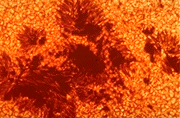


When you observed your sunspots, did the sizes change as the spots neared the Sun's limb? Ignoring for a moment that sunspot groups grow and shrink during their lifetimes, what should happen to a sunspot group as it appears to near the edge of the disk?
Remember, again, that the spots are actually traveling around on a huge ball. As you look at a spot group straight on, in the center of the disk, the group may appear quite large. But, as the spot starts to travel around out of your view, it will appear to become "scrunched" and get narrower as it goes around the limb of the Sun and out of view. A planet crossing in front of the Sun's disk would not change shape or "flatten" is it approached the Sun's limb. In 1769, a Scottish astronomer named Wilson noticed this "flattening" effect of sunspots.
In fact, by observing sunspots travel around the limb, Wilson could determine that the centers of sunspots were actually depressions in the Sun's surface, rather than "mountains" or high points.
Can you visualize how the spot might appear to grow wider and narrower? If not,
 Carefully watch the sun rotate
Carefully watch the sun rotate
 Back To "Are Sunspots Really on the Sun?"
Back To "Are Sunspots Really on the Sun?"
 |
 |
 |
 |
 |
 |
 |
 |
||||
 |
 |
 |
 |
This page is https://solar-center.stanford.edu/sunspots/galileo2.html
Last revised by DKS on July 29, 1997